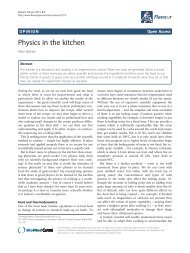(Coriandrum sativum) disliking among different ... - Flavour
(Coriandrum sativum) disliking among different ... - Flavour
(Coriandrum sativum) disliking among different ... - Flavour
Create successful ePaper yourself
Turn your PDF publications into a flip-book with our unique Google optimized e-Paper software.
Mauer and El-Sohemy <strong>Flavour</strong> 2012, 1:8 Page 2 of 5<br />
http://www.flavourjournal.com/content/1/1/8<br />
identified as being involved in consolidation and storage of<br />
gustatory memories, though research into the full extent of<br />
regions involved in this signaling is ongoing [14,15]. Formation<br />
of long-term memory involves new protein synthesis,<br />
whereas more rapid formation of short-term memory has<br />
been shown to be protein-independent. Formation of<br />
human taste memories is thus thought to involve novel<br />
protein synthesis; however, the time parameters of these<br />
processes are yet to be determined [16]. These memories<br />
are retrieved for comparison when a food is consumed,<br />
thus biological familiarity plays a role in taste preference.<br />
Similarly, olfaction is mediated by olfactory receptor neurons,<br />
which utilize a G-protein mechanism to transmit information<br />
about an odorant through the olfactory bulb to<br />
the olfactory cortex [17]. Odorant recognition helps the<br />
gustatory regions of the brain to identify the stimulus<br />
present in the oral cavity [12]. Perception of texture and<br />
consistency of foods is not mediated by one specific pathway,<br />
but could influence flavor intensity, likely by influencing<br />
the perception of tastants [18].<br />
It is currently unknown whether strong reactions to the<br />
flavor of cilantro are a result of odorants or tastants.<br />
Whereas some research has investigated odorants [19],<br />
taste mechanisms have yet to be examined, although anecdotal<br />
evidence indicates that those who find cilantro offensive<br />
dislike the taste as well as the smell. Gas<br />
chromatography-olfactometry and CharmAnalysis have<br />
been used to identify the character-impact odorants in the<br />
oil of cilantro leaves [19]. Thirty-eight odor-active peaks<br />
were isolated from a sample of cilantro oil. Of those, the<br />
two trained panelists qualitatively described 33 eluted<br />
compounds in the same way, but two co-eluting odorant<br />
clusters were described <strong>different</strong>ly by the two participants<br />
in the study [19]. Although only two individuals were<br />
involved in that study, the findings show that the odor<br />
profile is complex and perceived <strong>different</strong>ly between individuals.<br />
Genetic factors are known to influence perception<br />
of certain odors and tastes [20], and twin studies have suggested<br />
strong heritability for cilantro preference [1,3].<br />
However, no genetic factors associated with cilantro preference<br />
have yet been identified.<br />
Anecdotally, the polarizing nature of cilantro has been<br />
well documented [1,3]; however, the prevalence of cilantro<br />
dislike remains unknown. This observational study aimed<br />
to determine the prevalence of cilantro dislike in <strong>different</strong><br />
ethnocultural groups from a population of young adults.<br />
Results<br />
Table 1 shows the characteristics of the 1,381 subjects<br />
(419 male and 962 female) for which complete data were<br />
collected on all variables of interest. A total of 43% of<br />
females were Caucasian, which was significantly higher<br />
than the 40% of males who were Caucasian (P




